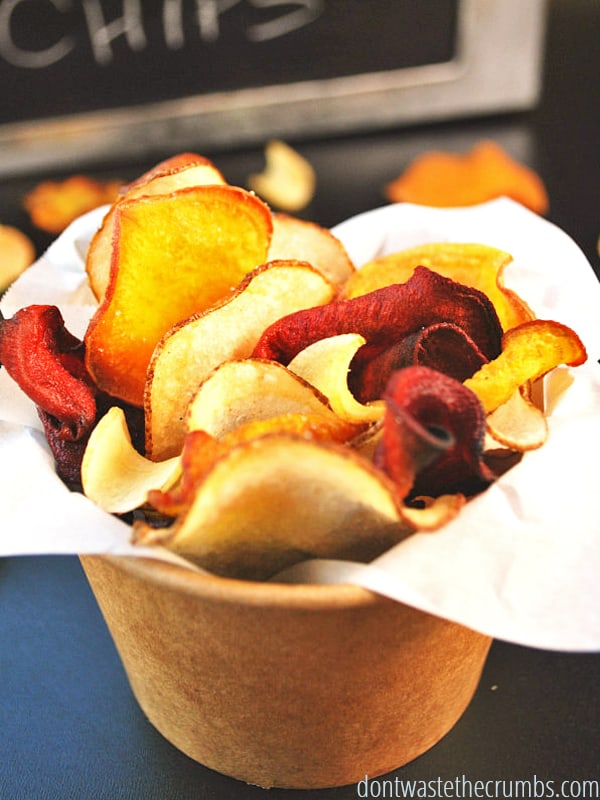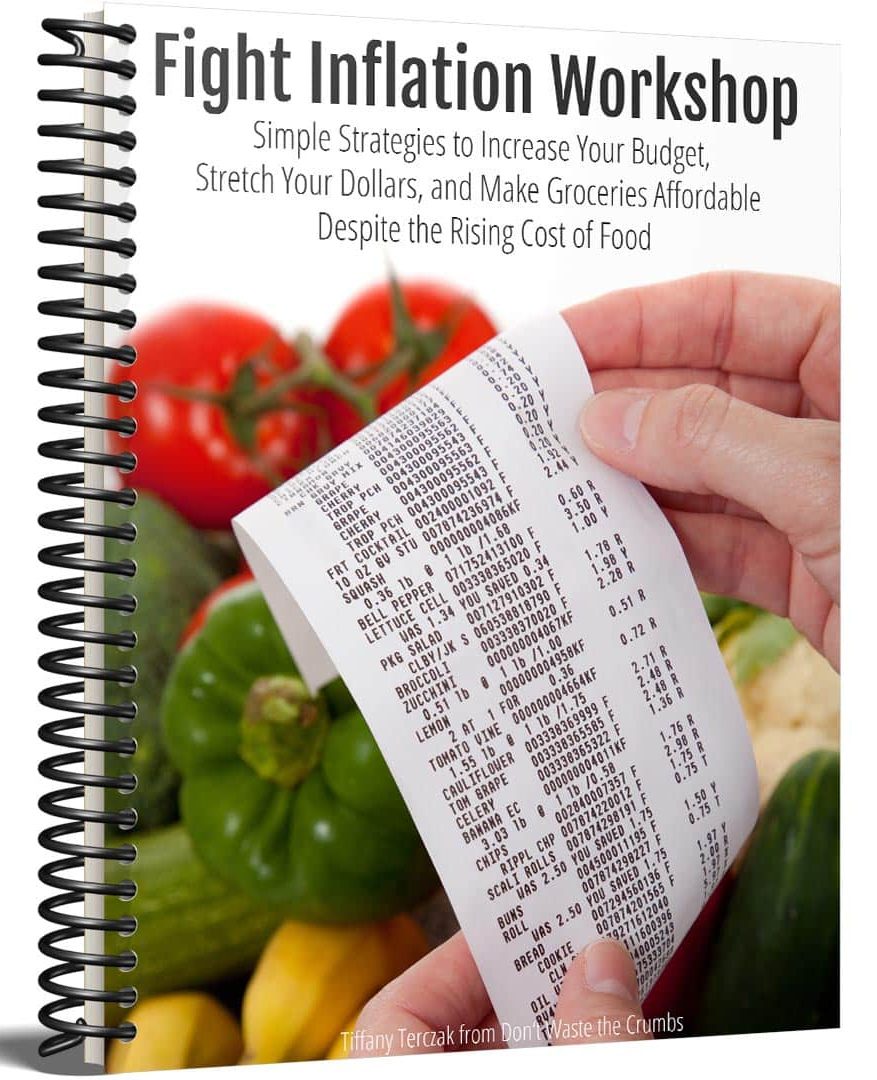Make these crunchy vegetable chips that are just like Terra chips, but better! Choose root vegetables like sweet potatoes, russet potatoes, and beets for a crispy, crunchy homemade snack.
Does anyone else love Terra vegetable chips, but absolutely cringe at the price as I do?
No doubt about it – those things are really good. But they’re also expensive! We love crunchy snacks like Homemade Tortilla Chips, High Protein Trail Mix, and Homemade Cheez-Its.
Since I like to make snacks from scratch, I decided to make vegetable chips myself…and, if I may say so, move over, Terra! These veggie chips are amazing!
WHY MAKE HOMEMADE ROOT VEGETABLE CHIPS
1. THEY’RE DELICIOUS.
My first attempt at frying chips at home was when I made homemade sweet potato chips a few weeks ago. The sweet potato chips were such a raving success, that I instantly began brainstorming about what I could fry up next.
With all the root vegetables and tubers in season, it seemed only right to make a batch of homemade root vegetable chips. Boy was that the right move. These things are amazing!
2. THEY’RE CHEAPER.
It’s not very hard to beat $4 a bag, which is what Terra’s Vegetable Chips cost at my local grocery store, and it’s even easier to beat the insane price on Amazon.
3. THEY’RE HEALTHIER.
For me, the quality of our food is just as important as keeping to the budget. These homemade root veggie chips are fried in pastured lard, as compared to the canola, safflower, or sunflower oil used in the store-bought variety.
Most of you are aware that saturated fat from animals allowed to roam and graze as God intended is healthy, despite what we’ve been told for decades.
This recipe also comes out gluten-free!
4. NOSTALGIA.
There’s something very gratifying about cooking from scratch over a pot of bubbling lard that came from pigs I visited on the farm – like I’m getting a taste of my great-grandmother’s life and moving one step closer to a “nose to tail” approach to eating.

,
INGREDIENTS FOR ROOT VEGGIE CHIPS
So, what do you need to make your own vegetable chips? Starchy vegetables will work best for this recipe. We’re going to skip the squash and zucchini!
- Root veggies
- Yuca root
- Parsnips
- Russet potato
- Sweet potatoes
- Golden beets
- Red beets
- Carrots
- Lard or tallow or red palm oil
- Sea salt
Psst! For the perfect salty crunch, try finishing this vegetable chips recipe with a pinch of finishing salt! I love Ava Jane’s Kitchen because it doesn’t have microplastics (gross, right?) and it’s SO GOOD! Plus, you can get a free 8oz. bag of sea salt (just pay shipping and handling!)
RENDERING LARD OR TALLOW FOR VEGGIE CHIPS
These chips can be fried in lard, tallow, or red palm oil. The more affordable of those options are lard and tallow, ranging from completely free (if you reserve portions of fat from beef or pork and store them in the freezer until you have a few pounds to render as lard), up to around $2/pound.
Using red palm oil will make these vegan veggie chips.
Never rendered before? It’s a cinch – I render pork fat on the stovetop, and it is excellent for roasting vegetables or making root veggie chips.
If you’re intentional about reserving beef or pork fat when cooking, you’ll enjoy an almost 50% discount off the price of root vegetable chips!
For those of you, like me, who purchase your fat from a farmer or organic butcher, you’ll only pay a few cents less than you would for Terra brand chips at the grocery store. However, your homemade version will be much healthier than the store-bought varieties fried in cheap oils that contain GMOs and less healthy omega-6 fats.
Note: If you don’t have access to grass-fed beef or high-quality pork locally, I recommend Butcher Box. You can read my honest review of their products here, and my post on how to make Butcher Box worth the cost!

HOW TO MAKE ROOT VEGETABLE CHIPS RECIPE
Step 1. Wash and trim the ends and stems from all vegetables.

Step 2. Heat lard/tallow in a large-diameter pot or Dutch oven over medium-high heat. (If it begins to bubble before the veggies are sliced, reduce the heat slightly to prevent burning).
Step 3. Meanwhile, slice the vegetables in small batches and in the order listed above to minimize oxidation while they wait their turn to be fried (start with just the yuca and parsnips – when those are almost done frying, slice the potato, and so on). The red beets can also discolor the lard, so be sure to fry them last.

Step 4. When the melted lard is 350-375 degrees or when a test slice crackles when dropped in, it’s ready. Drop enough slices to create a single layer on the surface of the lard. Cook for 2-3 minutes, using metal tongs to stir and flip the chips as needed to ensure even cooking.

Step 5. Use tongs to transfer the cooked chips from the pot to a lined baking sheet lined with a double layer of paper towels to absorb excess moisture. Sprinkle both sides with sea salt immediately. Add pepper if desired.
Step 6. Continue slicing and cooking in batches until all the vegetable chips are done to a perfectly crispy texture.

Step 7. Transfer cooled veggie chips to a serving bowl.
Cooked chips can be stored in a paper sack for up to a few days. If they lose their crisp, pop them in a 425-degree oven for just a few minutes before serving.
VEGETABLE CRISPS TIPS
- To slice the vegetables evenly, I recommend either a mandolin slicer or a food processor with the blade set at 1/16″ for thinner chips and ⅛″ for thicker, kettle-style chips. A knife will also get the job done if you have the skills and patience for that.
- I included parsnip and yuca in this recipe, but don’t sweat it if you can’t find these fresh vegetables. We thought the white potatoes, sweet potato, and beetroot chips were the best! You can also use purple sweet potatoes, turnips, or rutabagas if that’s what is available!
- To speed up the process, consider using two large-diameter cooking pots. Doubling the surface area will reduce your cooking time by half!
- If you’ve ever fried anything before, you know that the temperature of the fat is key. Not hot enough, and the chips will absorb too much fat and won’t crisp. Too hot, and they’ll burn.
- I highly recommend using a thermometer if you have one. It really makes high-heat cooking easier, but I use it for Homemade Yogurt and Salted Caramel too.
- If you don’t have a thermometer, just be sure to test-fry one or two veggie slices before adding more.

VEGETABLE CHIPS FAQS
Are root vegetable chips better than potato chips?
Yes, when you choose a vegetable chip over a potato chip, you will be getting less sodium and more fiber!
What are the best vegetables for chips?
This root vegetable chips recipe consists of yuca root, parsnips, russet potato, sweet potatoes, and beets. We liked the flavor of the potatoes, sweet potatoes, and beets the best because the frying brings out the hint of sweetness in the root veggies.
Can you make vegetable crisps in an air fryer?
Probably, but I haven’t tried that. You would still need to slice the vegetables thinly and coat them with fat before air frying them in a single layer. Depending on the size of your air fryer, you might need to do quite a few batches!
MORE SNACK RECIPES

Fight Inflation Workshop!
Sign up for my FREE Fight Inflation Workshop and learn simple strategies to save money, even with rising food costs!
WATCH HOW TO MAKE HOMEMADE VEGETABLE CHIPS
Root Vegetable Chips
Make these crunchy vegetable chips that are just like Terra chips, but better! Choose root vegetables like sweet potatoes, russet potatoes, and beets for a crispy, crunchy homemade snack.
- Prep Time: 10 minutes
- Cook Time: 10 minutes
- Total Time: 20 minutes
- Yield: 16 oz 1x
- Category: Snacks
- Method: Stovetop
- Cuisine: American
Instructions
- Wash and trim ends/stems from all vegetables.
- Heat lard/tallow in a large diameter pot or Dutch oven over medium-high heat. (If it begins to bubble before the veggies are sliced, reduce heat a tad to prevent burning).
- Meanwhile, slice the vegetables in small batches and in the order listed above to minimize oxidation while they wait their turn to be fried (start with just the yuca and parsnips – when those are almost done frying, slice the potato, and so on). The red beets can also discolor the lard, so be sure to fry them last.
- When the melted lard is 350-375 degrees or when a test slice crackles when dropped in, it’s ready. Drop enough slices to create a single layer on the surface of the lard. Cook for 2-3 minutes, using metal tongs to stir/flip chips as needed to ensure even cooking.
- Use tongs to transfer cooked chips from the pot to a large surface line with a double layer of paper towels to absorb moisture. Sprinkle both sides with sea salt immediately.
- Continue slicing and cooking in batches until all are done.
- Transfer cooled chips to a serving bowl.
Notes
- Cooked chips can be stored in a paper sack for up to a few days. If they lose their crisp, pop them in a 425-degree oven for just a few minutes before serving.
- I included parsnip and yuca in this recipe, but don’t sweat it if you can’t find these. We thought the potato, sweet potato, and beet chips were the best!
- To speed up the process, consider using two large-diameter cooking pots. Doubling the surface area will reduce your cooking time by half!
- If you’ve ever fried anything before, you know that the temperature of the fat is key. Not hot enough, and the chips will absorb too much fat and won’t crisp. Too hot, and they’ll burn. I highly recommend using a thermometer if you have one. It really makes high-heat cooking easier. If you don’t have one, just be sure to test-fry one or two veggie slices before adding more.



